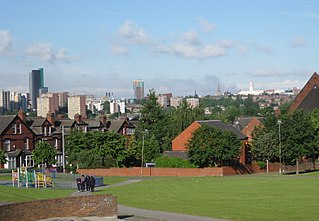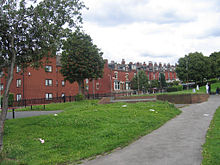
Harehills is an inner-city area of east Leeds, West Yorkshire, England. It is about 1 mile (1.6 km) northeast of Leeds city centre. Harehills is between the A58 and the A64. It sits in the Gipton & Harehills ward of Leeds City Council and the Leeds East parliamentary constituency, between Burmantofts and Gipton, and adjacent to Chapeltown.

Chapeltown is a suburb of north-east Leeds, in West Yorkshire, England. It is part of the Leeds City Council Ward of Chapel Allerton. It is approximately one mile north of Leeds city centre.

The Leeds Carnival, also called the Leeds West Indian Carnival or the Chapeltown Carnival, is one of the longest running West Indian carnivals in Europe, having been going since 1967. The carnival is held in the Chapeltown and Harehills parts of Leeds every August bank holiday weekend. Attendance is estimated at 150,000.

The 1981 Brixton riot, or Brixton uprising, was a series of clashes between mainly black youths and the Metropolitan Police in Brixton, London, between 10 and 12 April 1981. It resulted from racist discrimination against the black community by the mainly white police, especially the police's increased use of stop-and-search in the area, and ongoing tensions resulting from the deaths of 13 black teenagers and young adults in the suspicious New Cross house fire that January. The main riot on 11 April, dubbed "Bloody Saturday" by Time magazine, resulted in 279 injuries to police and 45 injuries to members of the public; over a hundred vehicles were burned, including 56 police vehicles; almost 150 buildings were damaged, thirty of which were burnt out, and many shops were looted. There were 82 arrests. Reports suggested that up to 5,000 people were involved. The Brixton riot was followed by similar riots in July in many other English cities and towns. The Thatcher government commissioned an inquiry, which resulted in the Scarman Report.

The Bradford Riots were a brief period of violent rioting which began on 7 July 2001, in Bradford, West Yorkshire, England. They occurred as a result of heightened tension between the large and growing British Asian communities and the confrontation between the left wing Anti-Nazi League and far right groups such as the British National Party and the National Front. Similar ethnic riots had occurred earlier in other parts of Northern England, such as Oldham in May and Burnley in June.

West Yorkshire Police, formerly the West Yorkshire Metropolitan Police, is the territorial police force responsible for policing the metropolitan county of West Yorkshire, England. It is the fourth largest territorial police force in England and Wales by number of officers.
The Oldham riots were a brief period of violent rioting which occurred in Oldham, a town in Greater Manchester, England, in May 2001. They were ethnically-motivated riots and the worst riots in the United Kingdom since 1990.
The MIGs are a football hooligan "firm" associated with the English football club Luton Town, which was originally formed in the 1980s.

The 2008 UEFA Cup final riots took place in Manchester, England, on the day of the 2008 UEFA Cup final. Serious disorder was allegedly sparked by the failure of a big screen erected in Piccadilly Gardens to transmit the match to thousands of Rangers fans who had travelled to the city without tickets. In addition to property damage, fifteen policemen were injured and ambulance crews attended 52 cases of assault. A Manchester City Council inquiry into the events estimated that over 200,000 Rangers fans visited Manchester for the match, with 39 fans arrested for a range of offences across the city, while 38 complaints were received about the conduct of Greater Manchester Police officers.
The Chapeltown riotsof 1987 took place in the Leeds district of Chapeltown in West Yorkshire, England. Widespread rioting in Chapeltown also occurred in 1975 and 1981. During the 1981 riots, rioting took place not only in Chapeltown, but also in London, Birmingham and Liverpool.
The Chapeltown riot occurred on 5 November 1975 in the troubled Leeds district of Chapeltown in West Yorkshire, England. They were not to be the last riots in the area with further rioting in 1981 and 1987 and rioting in nearby Harehills in 2001.
In April and July 1981, there were riots in several cities and towns in England. The riots mainly involved black English youth clashing with police. They were caused by tension between black people and the police, especially perceived racist discrimination against black people through increased use of stop-and-search, and were also fuelled by inner-city deprivation. The most serious riots were the April Brixton riots in London, followed in July by the Toxteth riots in Liverpool, the Handsworth riots in Birmingham, the Chapeltown riots in Leeds, and the Moss Side riots in Manchester. There were also a series of less serious riots in other towns and cities. As a result of the riots, the government commissioned the Scarman Report.

The Ghulja, Gulja, or Yining incident was the culmination of the Ghulja protests of 1997, a series of demonstrations in the city of Yining—known as Ghulja in Uyghur—in the Xinjiang autonomous region of China.

A series of riots took place between 6 and 11 August 2011 in cities and towns across England, which saw looting and arson, as well as mass deployment of police and the deaths of five people.

In early August 2011, England was struck by riots, the worst in the country in decades. The timeline of the events of the riots spanned from 6–10 August.
The 2000 UEFA Cup Final Riots, also known as the Battle of Copenhagen, were a series of riots in City Hall Square, Copenhagen, Denmark between fans of English football team Arsenal and Turkish team Galatasaray around the 2000 UEFA Cup Final on 17 May 2000. Four people were stabbed in the scuffles, which also involved fans from other clubs and were viewed by the media as part of a retaliation for the killing of two Leeds United fans by Galatasaray supporters the month before.
The Chapeltown Riots of 1981 took place in the Leeds district of Chapeltown in West Yorkshire, England, during a time when many other areas of the UK were suffering similar problems. The riots unfolded in July 1981 from a background of racial tension, inner city poverty, poor housing and high unemployment. This brought high tension, particularly amongst the area's Caribbean community, culminating in attacks on the local police.

On 18 July 2024, a riot took place in the Harehills area of Leeds, Yorkshire, England. The incident was triggered by a dispute over four children of a Romani family being taken into care by social services and police.











